14 November, 1999
Getting ready for the fieldwork in Antarctica requires days of preparations
and packing. In addition to their science skills the researchers must know
how to handle themselves in this harsh environment. Mcmurdo provides
several training classes, which are required of everyone going to a remote
field station. Since Mt Erebus is considered a remote field station we all
attended several of these courses.

One of the ways we will be getting around on the mountain and hauling our equipment is by ski mobile. Once in the field there will be no one to help us if we break down so all of us take a quick course in ski doo mechanics.
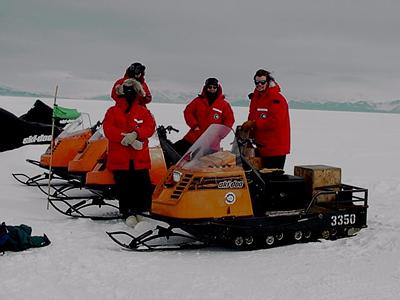
Then for a test drive, not all the activities here in Antarctica are work. Here we are enjoying a ride out on the Ross Ice Shelf testing the machines that will be working with us on Mt Erebus

Driving the dki doos out on the ice shelf we stop to look at this ice cliff. Here a glacier from the land meets the ocean. Large parts of this glacier that break off(calve) are called ice bergs. The largest known ice berg was a big as Belgium.
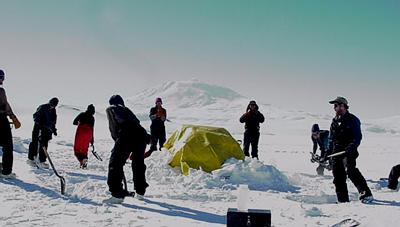
Outdoor safety training and survival skills are necessary before we can be sent to our field site. Each member of our team must spend 2 days on the ice living out of our survival bags simulating an emergency situation where we are far from the station and help can not get to us. They take us to a remote area outside of Mcmurdo on the Ross Ice Shelf. Here we must work as a team to build a camp on the ice for protection against the weather. In these pictures we are building an emergency snow dome for shelter. Jeff will sleep in the dome this night.
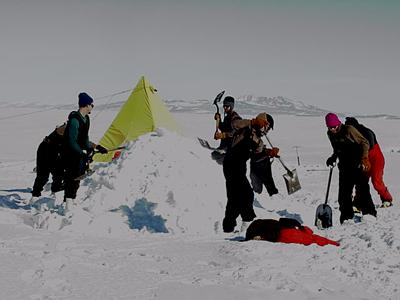
The mound grows. We use our sleep bags as a form and pile the snow around them. Packing down the snow with our tools helps the snow dome become solid and safe to sleep in
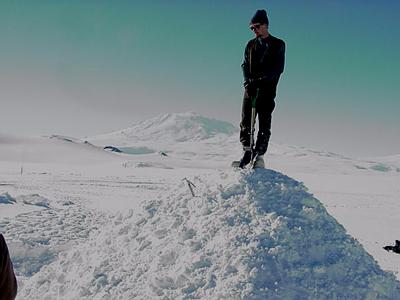
The mound is complete. Jeff plays king of the mountain with Mt Erebus as a backdrop. He slept in the mound for the night and said it was warm and cozy. Yeah sure Jeff!
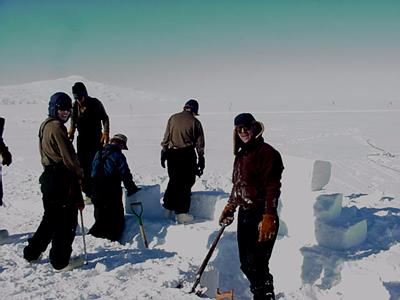
To protect us from the wind, we cut snow blocks with handsaws from the ice shelf to build a wall. The wall is positioned facing south because most of the big storms come from that direction.
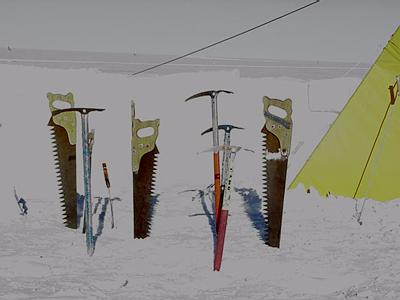
Finally the camp is complete and we set our tools aside. Cutting the blocks for the wall was more work than I thought. I sure hope we never have to do this job in a raging storm.
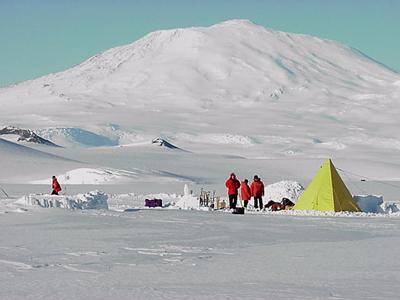
Camp is made. The Scott tent on the right sleeps three and was very cozy. Remember the large yellow tents folded up in the picture in yesterdays journal? Well this is what it looks like set up. Jesse spent the night there, while I slept in the yellow tent on the left. This one is similar to the tent we will use on Mt Erebus for 6 weeks so this was good practice in setting up and making ourselves comfortable. Notice it is below the surface line. We have dug out a tent space in front of the wall for further protection from the wind. Dinner is served and we sleep in the snow for the first time since coming to this land of ice, wind and snow. Yes that is Mt Erebus in the back.

When a field party is away from base, radios are essential safety equipment. We will be carrying two kinds. Small hand held VHF radios allow us to contact Mcmurdo base from the mountain using a repeater from across the ice shelf. The larger radios in the red box are for emergencies and need to have their antenna set up to send and receive messages. Here we field-test the radios we will be using, contacting the South Pole just for fun.
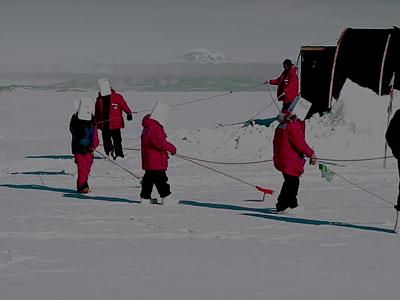
White out is a condition in Antarctica that comes quickly and is serious. A person who is caught away from shelter can become disoriented and lost very fast. Here the team goes through an exercise in finding a lost person during a white out. We are roped together so we don't get lost and swing a small stick in front to help find our friend who might be unconscious in the snow. The bucket over our heads help to simulate the white out conditions.

Because our camp on Mt Erebus will be at 12,000ft our group learned about preventing altitude sickness and the use of a Gamow bag in case one of our team members becomes sick. If someone does begin to have sever symptoms from altitude sickness they are placed into the bag and air is pumped in to increase the pressure around the body. This simulates being at a lower altitude which is the only cure for this condition. These bags have saved people when they are in areas where getting to a lower altitude quickly is impossible.

Contact the TEA in the field at
.
If you cannot connect through your browser, copy the
TEA's e-mail address in the "To:" line of
your favorite e-mail package.
|
